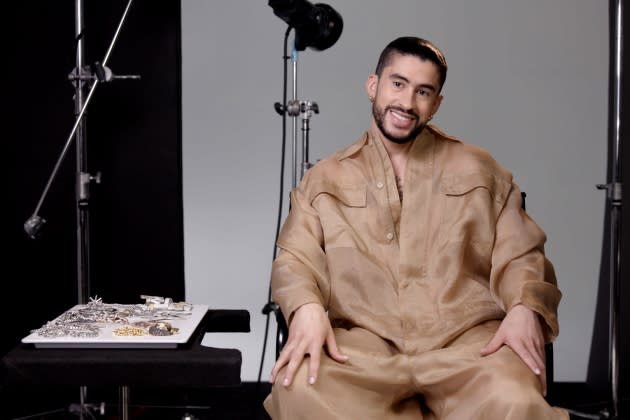Bad Bunny Honors the Reggaetoneros That Came Before Him in ‘Rolling Stone’ Cover Shoot: Watch

Everywhere he goes, Bad Bunny represents where he comes from and the artists who inspired him. For his Rolling Stone cover story, out today, the Puerto Rican star wanted to honor the reggaeton heroes he looked up to as a kid by wearing jewel-encrusted medallion necklaces featuring their logos. Designed by Avi Davidov and Ofir Ben-Shimon, the medallions represent the decades-long careers of Puerto Rican luminaries Tego Calderón, Héctor El Father, Wisin Y Yandel, Arcángel, Don Omar, and Daddy Yankee.
“These chains are of the people whose music I grew up with,” he tells Rolling Stone in an exclusive video interview, which you can watch above. “They’re more than an entire generation.”
More from Rolling Stone
Bad Bunny ya ha conquistado el mundo. ?Qué le queda por hacer?
Bad Bunny, Karol G, Daddy Yankee, and More Stars Want This Reggaetón Lawsuit Thrown Out
Bad Bunny had been toying with the idea for a long time, thinking he would wear the necklaces to pay homage to the reggaeton greats at a major concert or public appearance.
“When the opportunity to shoot with Rolling Stone came along, I was like, ‘Damn, that would be perfect.’” He sees himself as part of the lineage of these artists and carrying on their legacy. “That’s my foundation,” he says. “I’ve taken something from all these artists I’ve listened to and loved.”
Bad Bunny remembers asking for CDs as a gift for both Christmas and Three Kings Day. One he got — a CD by Héctor El Father — sticks out in his mind. “My parents probably regretted giving it to me,” he says with a laugh. “I’d be up at 5 a.m. playing the music at full volume.”
Of the artists he chose to represent with chains, Arcángel is the youngest. He arrived on the scene when the biggest reggeatoneros were at their peak and started acting as such. But Arcángel arrived and, as Bad Bunny puts it, “became a phenomenon” and “an automatic legend” while still being a sort of rookie or underdog.”
“He was versatile… He could talk about the streets or drop an album for discotheques. I was 13 when he came out and he was my favorite artist,” he says. “He was one of the first artists with whom I’ve collaborated with. Now I think about it and it’s like, ‘I’m with him [on stage].’ It’ll always be impressive.”
Don Omar? “He’s probably the one of the group I was least a fan of, but if you play any of his songs, I’m sure I know all the words,” he says with a smirk. “Loving his music is inevitable… He had that flow and could connect with people.”
Daddy Yankee? “That’s what people associate with the word reggaetón. There isn’t a single person of my generation who wouldn’t listen to his music,” he says. “His contribution to reggaetón was huge and will never be erased.”
On Wisin y Yandel, Bad Bunny acknowledges how ahead of the curve they always were with both their music and visuals at the time. As a kid, he remembers always listening to one of their albums with his cousins, and wanting to attend one of their shows, but not being able to. “I never could,” he says. “But then I ended up singing with them.”
Bad Bunny fanboys the most when speaking on Tego Calderón’s legacy. “Meeting him was the most special moment of my life,” he says. “I always dreamt of meeting him… The goal of becoming an artist started with him. He was the first artist I loved.”
Bad Bunny bows his head: “You have to pay reverence and respect to him.”
Best of Rolling Stone